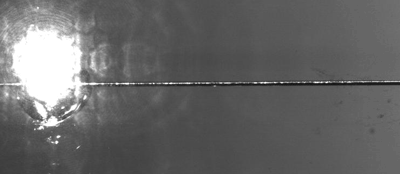

The goal of lab-on-a-chip devices is to perform standard laboratory functions with microliter fluid samples. There are many advantages to such precision technology: lower reagent usage, faster response times, lower capital equipment investment, compactness, portability and lower overall cost. Moreover, this technology has the potential to usher in a new age of personalized medicine. In order to realize these advantages there are several key scientific and technological challenges to be overcome.
We demonstrate a new method of droplet transport actuated with light that exploits optical effects in semiconductors. We developed a thermodynamic model for the wetting behavior of a single static drop on a semiconductor (see #1) analogous to the Young-Lippmann equation, and showed how this phenomenon can be used to translate a drop (see #2). This technology is superior to the usual electrowetting-on-dielectric method because it requires neither the deposition of an array of electrodes nor the complicated multiplexing scheme to address each electrode.w3